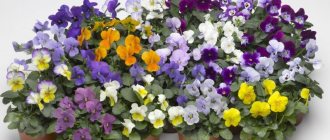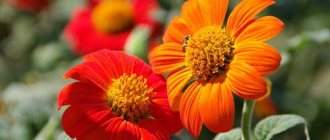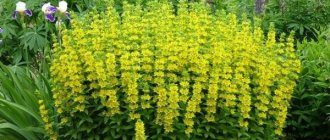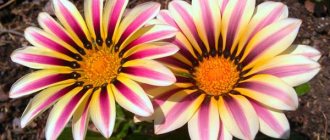A delicate yellow flower on a cushion of wide leaves, reminiscent of a buttercup, is marigold, a plant found both in the wild and in garden plots. Despite its modest size, the marigold is unusually cute. It fits perfectly into landscape ensembles made in a natural style, and in a natural environment it decorates the banks of rivers and streams, standing out brightly against the backdrop of rich greenery.
Domestic flower growers, spoiled by the numerous exotics that poured into us from neighboring countries, have forgotten a little about this pleasant flower. Meanwhile, marigold is not only beautiful, but also perfectly adapted for temperate latitudes. It is very simple to grow it in your garden plot; moreover, this plant is a perennial, and therefore does not require grueling annual planting.
Marigold is not only beautiful, but also useful:
- Traditional healers, based on various parts of the plant, make decoctions and infusions that cure bronchopulmonary diseases, skin lesions, liver diseases, colds, and anemia.
- The buds, boiled in the marinade, are eaten. Their taste is a bit like that of capers.
- Dried tops of stems and ground roots are used as a seasoning for meat, fish, and also as an additive to bread dough.
- Marigold is an excellent honey plant and attracts many bees.
[!] Marigold contains several active substances, some of them are poisonous. The plant should not be ingested uncontrollably, as this may cause poisoning.
This beautifully flowering representative of the kingdom of Flora has served as an inspiration for poets, writers and artists; for example, the plant appears in Shakespeare's play Cymbeline. Well, more often than not, people simply admire a pretty flower when they plant it in their garden plots.
The Russian name – kaluzhnitsa – is derived from the word “kaluzha”, which in Old Russian meant a puddle or swamp. The name indicates the plant's special affinity for water. The Latin name - Caltha - is translated from Greek as “cup”, “bowl” or “glass”.
In addition to the official name, marigold has many popular names: snake grass, cow flower, paddling pool, toad grass, water snake - in Russia and crazy Beth, bull lily, water cradle or shoe, water dragon, royal cup - abroad. In England, the flower is most often called Mary's gold. This is due to the medieval tradition of offering marigold as a gift to the Immaculate Virgin on Easter.
It is difficult to name the homeland of the plant - now it can be found on all continents, with the exception of the Arctic. Frost-resistant species grow in North America, Siberia, Scandinavia, Greenland, etc. More thermophilic ones are found in Australia and New Zealand, in the foothills of the Alps, in the tropics and subtropics of Africa and South America.
From a botanical point of view, marigold (Latin Caltha) is a whole genus of perennial herbaceous plants from the buttercup family (Latin Ranunculaceae), usually growing in swamps, ditches and damp forests. They share several common characteristics: a short branched rhizome, wide smooth heart-shaped or kidney-shaped leaves and large single flowers appearing from the center of a leaf rosette, with five or more petals. The petals are usually yellow or white, but pink varieties are also found. The flowering time for most types of marigold is April-August, depending on the region. After flowering, the fruit appears - many leaves with a small number of seeds.
Popular varieties of terry marigold with photos
Terry marsh marigold (Latin name Cáltha palústris) is a separate species of the marigold plant of the buttercup family and the most common in ornamental gardening. This type includes several popular varieties:
| Variety | Description | Recommended soil | Suitable growing region |
| Auenwald | Powerful bush with large rounded heart-shaped leaves | Clay, rich in nutrients | Russian Center and Black Earth Region |
| Osternach | Tall plant, fleshy stem, flowers reach up to 7 cm in diameter. | Rocky, moderately wet | North and northwest Russia |
| Plena | The stem is thick and soft, blooms profusely, the flowers are shaped like pompoms. | Dry (subject to abundant watering, loamy | Southern regions |
Auenwald is considered the most frost-resistant subspecies; it is also well suited for growing in Moscow and the Moscow region.
Auenwald
Osternach
Plena
Main advantages of the plant:
- spectacular appearance;
- friendly flowering;
- grows and reproduces quickly;
- tolerates sudden temperature changes well.
One of the disadvantages is “aggressiveness”: growing in the area, this marsh flower does not allow other crops to grow, drowning them out (a similar situation often occurs with lilies). This crop also needs abundant watering. If proper conditions are not created for the plant, the flowering period will be short.
You should not plant marigold if there are always children or animals on the site. Its stems, leaves and flowers contain toxic substances.
Botanical description
Marsh marigold and its two garden forms are grown as ornamental plants. The stem of the plants is fleshy, bare, leafy, sometimes recumbent, but usually erect - ascending or ascending. The height of marigold can reach from 3 to 40 cm. The cord-like roots of the plant are collected in a bunch.
The entire, alternate, heart-shaped or kidney-shaped, dark green, glabrous and shiny marigold leaves have crenate or crenate-toothed edges. The basal leaves sit on long succulent petioles and reach 20 cm in diameter. The bracts of marigold are sessile. In the axils of the upper leaves in April or May, long peduncles develop, on which up to 7 orange, yellow or golden flowers with a diameter of up to 5 mm are formed. The corolla of flowers consists of 5 leaflets up to 25 mm long. The fruit of the marsh marigold is multi-leafed: the number of leaflets corresponds to the number of pistils, which can be from 2 to 12 in a flower. Up to a dozen black shiny seeds ripen in each leaflet.
All parts of marsh marigold are slightly poisonous.
- Zucchini: growing in the garden, varieties
Choosing a site for planting and preparing the soil
When choosing a landing site, you should consider that:
- Terry marsh marigold loves open places and increased soil moisture;
- when the plant blooms, the area should be well lit;
- Planting in dry soil is possible provided there is abundant watering, especially in the first time after planting;
- You can place the seedlings in partial shade falling from garden fruit and berry trees (apple trees, pears or plums), provided that no other flowers or vegetables grow nearby.
The soil should be well dug and moist.
Using marsh marigold in garden design
Marigolds are irreplaceable near bodies of water and in damp places. One of the earliest beautifully flowering coastal plants, whose foliage grows and remains quite decorative all summer. When decorating the banks of decorative ponds and streams, marigolds can be successfully used, creating juicy bright yellow spots both in pure plantings and when adjacent to other plants.
It is advisable to select marigold species that match environmental needs and that complement each other in terms of flowering time and the color of flowering and vegetative plants. Marigold should be planted in such a way that during flowering it is not blocked by other plants, and after flowering, when it loses its decorative effect, species with late-growing leaves are in the foreground.
The best partners for marsh marigold : Soft lungwort, Alpine forget-me-not, Brunnera, Krasodnev, Ostrich, Snake knotweed, Chinese astilbe, Bergenia thick-leaved, Hosta.
Care
The list of basic care activities includes:
- watering;
- feeding;
- disease and pest control;
- loosening the soil.
Terry marsh marigold rarely gets sick and is practically not affected by fungus. It also tolerates frost well.
Light and humidity requirements
This marsh flower should grow in open areas or partial shade. The gardener must ensure that the soil is constantly slightly moist; it should not be allowed to dry out completely.
Features of feeding
Feeding should be done three times during one season. It is recommended to use mineral complexes for garden plants. Seedlings should be planted in well-manured soil.
It is strictly forbidden to use liquid undiluted mullein for feeding, otherwise the flower may receive severe burns.
Care according to the seasons
In the spring, you should carry out the first fertilizing using organic matter. A transplant can be done. In summer, it is necessary to periodically weed the soil and mulch so that water does not evaporate from the ground. At the end of June - beginning of July, a second feeding with a mineral complex is carried out.
Autumn care is the last feeding, pruning (removing dried and diseased leaves) and mulching. The plant is frost-resistant, so special preparation for winter (shelter) is not required. During the flowering period, experts recommend mineral fertilizing; When the marigold fades, the flower stalks should be removed.
It happens that the leaves of a plant suddenly begin to dry out for no apparent reason, and the flowers begin to crumble. Most often, the reason lies in poor soil moisture. It is enough to increase watering, and within a few days the wilting will stop.
4.Reproduction
4.1.Growing marigold from seeds
Unfortunately, seed propagation, although often successful, takes an impressive amount of time. In order for the first buds to decorate the bushes of marigold grown from seeds, about 2 - 10 years must pass.
Seeds are sown in the garden in early June, immediately after ripening and harvesting, or in mid-autumn, choosing such a period of time so that the first shoots do not have time to appear before the onset of frost. With summer sowing, the first leaves will appear in August, and with winter sowing - next spring.
↑ Up,
You can use seeds collected by yourself, but in varietal plants, external characteristics may be lost during such propagation. Only species-specific marigolds will completely retain their appearance.
Planting material should be used in the year of collection or, in extreme cases, the next. Seeds collected 2 years or more ago will lose their viability.
An area of soil is weeded and loosened, then watered generously with plenty of water and seeds are sown directly on the surface of the ground. Planting material should not be planted on top - the seeds need light to germinate.
↑ Up,
When planting in seedling boxes and growing seedlings in the house, the planting material must be subjected to cool stratification. Stratification will increase the germination of planting material.
For this period, the seeds are placed in the vegetable compartment in the refrigerator for a month and then the temperature is raised to 16 - 18 degrees; the seeds are stored in this way for another 2 months. At the end of the second period, the first shoots can usually be observed.
Seedlings are planted in open ground in May - June.
↑ Up,
4.2.Plant division
Every 3 - 4 years, marigold bushes can be replanted and divided for rejuvenation. This event should be held in the summer months, after complete flowering. Some varieties tolerate division in the spring, but often this will affect flowering.
In order for the bushes to endure division more easily and adapt faster in a new place, it is worth postponing the replanting until the onset of cool, cloudy weather and doing it in the evening hours. To do this, the plants are removed from the ground and the root system is shaken off from soil residues.
The bush is divided by hand, if necessary, resorting to a sharp and sterilized garden tool - pruning shears or a knife. As it forms, the wound surface is treated with finely crushed charcoal or ash.
↑ Up,
As a result of division, each part should receive a well-developed root system and several leaves of its own.
Some varieties with large rhizomes are propagated by cuttings of rhizomes. Such flowers are dug up in the summer or early autumn, shaken off the remaining soil and the roots are inspected - if necessary, rotten and old, dead roots are removed with pruners, cutting them to healthy tissue.
The rhizomes are cut into pieces so that each section contains its own renewal bud. The resulting segments are planted separately at a distance of about 30 - 40 cm from each other and watered abundantly.
↑ Up,
4.3. Reproduction by air layering
In early June, marigold stems with leaf buds are pressed to the surface of the soil and pinned. Sprinkle a small layer of soil on top of such a layer and keep it evenly moist all the time. Leaf nodes should be constantly buried - make sure that the soil above them does not erode during watering.
After some time, signs of new growth will appear - this will indicate that the first roots have appeared under the surface of the earth in the leaf node. Such cuttings are completely separated from the mother bush next year.
↑ Up,
4.4.Cuttings
Stem cuttings can be used as another method of propagation. Cuttings are separated from the mother bushes in late spring - early summer. The bases of the cuttings can be treated with growth stimulants. Rooting is usually carried out in a glass of warm water.
The water is changed every 5-6 days, and to prevent it from spoiling ahead of time, add an activated carbon tablet. When the roots reach a length of 1 - 2 cm, the flower can be planted in the garden.
↑ Up,
Medicinal properties
Despite its toxicity, the plant is considered medicinal. It is known that marigold juice is widely used in folk medicine for:
- poisoning;
- stomach upsets;
- boils;
- non-healing wounds.
The root of the flower is used in the treatment of anemia and some cancers. At the pharmacy you can buy dried shoots and flowers to treat bronchitis, pneumonia and asthma. Marigold is also considered an effective antitussive for whooping cough and allergic cough. However, it cannot be used to treat children due to toxicity.
In order for the marigold to grow well, it is necessary to provide the flower with conditions close to natural: a large amount of light and high air humidity. An unusual, bright plant will decorate your summer cottage and fit into any landscape design. The ease of maintenance makes marigold especially popular among novice summer residents and gardeners.
When and how does it bloom
Flowering shrubs for the garden, perennial and unpretentious
Flowering duration is 2 months (April and May). There is a gradual opening of buds on oblong peduncles. The petals absorb sunlight, creating a warm atmosphere inside the bud, which begins to gain color. The flower has 5 petals and a simple perianth. There are ordinary flowers with a smooth surface of the petals, and there are terry or velvet ones.
Note! Plants that reach the age of 8-10 years bloom. Plants grown from seeds bloom within 2-3 years.
At the very beginning of flowering, you need to apply a small amount of mineral fertilizers. This will help all the buds form correctly and become voluminous and lush. At the end of the flowering period, all inflorescences that have dried out are cut off. This must be done to grow a bright green decorative mass.
Marsh marigold needs to be sprayed once a week
Dangers awaiting you
Of course, it should be noted that, like many ranunculus herbs, marigold is very poisonous. Its composition has long been studied - it contains saponins, alkaloids and other very toxic substances.
Based on the studies conducted, we can conclude that the plant is toxic and always dangerous to human health - when any part of it is eaten, the picture of poisoning is as follows: diarrhea, colic - from the stomach.
From the side of the kidneys, the poison of the plant can reveal itself as follows: urine changes color and is often excreted.
And also, all the troubles will most likely be aggravated by dizziness, mild headache and, possibly, ringing in the ears. Fortunately, poisoning from marsh marigold can be treated.
To do this, use regular activated carbon, as well as some types of laxatives. It is even possible to use egg white and starch paste as enveloping agents.
However, we do not advise you to go beyond these treatment methods - it is best to consult a doctor if there is no result. By the way, this plant in the past could also be used in the treatment of liver and skin diseases. But, given the danger of such treatment. Modern medicine, with the exception of homeopathy, does not use this flower in any type of therapy.
Possible problems during cultivation
Marigold has good immunity from pests and diseases. The main pest for marigold, which poses a real danger, is several varieties of flies. The eggs they lay can be found on the juiciest leaves. It is easy to fight them, since there are only a small number of them. Sometimes it is enough to simply cut off the leaves that have eggs or already larvae.
The plant sheds buds and leaves
The only thing you may encounter when growing is poor flowering. This is due to a lack of moisture or insufficient light. You should increase watering and move (transplant) the flower to a sunnier place.
Attention! The buds may be shed if propagation by division occurs during the growing season. This is normal and everything will recover over time.
Pale leaves or rust on them is a sign of powdery mildew. It is enough to treat with Bordeaux mixture. If the tips dry out, it means insufficient watering or the climate is too hot.
Marsh marigold is a plant that, if grown correctly, can not only decorate any place where it is planted. It can also help with various diseases.











